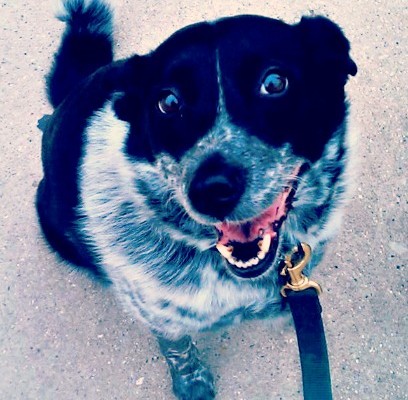March 31, 2015
Winter officially turned to spring last week, and here in Chicago, that means that the piles of ice and snow that we have become accustomed to over the past three months will finally melt away. What is revealed beneath is something we barely recognize, but if we reach back into our memories, we faintly recall gardens, grass, and other nice, spring-like things.
What we actually find is something much less appealing: pits of mud and a season’s worth of garbage and, yes, poop. We’ve all been there. It’s zero degrees outside with blustering winds, and after the dog found her spot, it simply disappeared into the mound of snow awaiting rediscovery some months later, not unlike an archeological find.
 Which brings us to Squirrely. She is an Australian Cattle Dog mix that my wife and I adopted in June of 2010 from the Anti-Cruelty Society of Chicago. At the time, she was 30 pounds overweight, suffering from a bad case of kennel cough, and had worn the fur on her little elbows bare. They said she was about 6 years old, though our vet said that her obesity probably made her look older than she really was. We picked a real winner. Her background was unknown, but we suspect she was neglected in a kennel in a basement somewhere without much exercise or socialization. She also brought with her the disgusting habit of eating whatever she finds along our walks, including and especially, tasty turds of any kind.
Which brings us to Squirrely. She is an Australian Cattle Dog mix that my wife and I adopted in June of 2010 from the Anti-Cruelty Society of Chicago. At the time, she was 30 pounds overweight, suffering from a bad case of kennel cough, and had worn the fur on her little elbows bare. They said she was about 6 years old, though our vet said that her obesity probably made her look older than she really was. We picked a real winner. Her background was unknown, but we suspect she was neglected in a kennel in a basement somewhere without much exercise or socialization. She also brought with her the disgusting habit of eating whatever she finds along our walks, including and especially, tasty turds of any kind.
Spring is Squirrely’s favorite time of year. All of the repulsive things that have lurked beneath the snow are now defrosted and ready for consumption. Aside from just being generally gross, there is a high risk that she will become sick due to bacteria in that poo.
Why does she do this? Is it a learned behavior? An instinct gone awry? Or some kind of condition? How do we stop her?
The canine behavior of eating feces is called coprophagia. It is not known why some dogs exhibit this behavior, but many theories have been suggested. One thought is that wild dogs and wolves developed the habit of cleaning up around their dens to hide their scent from other predators. Another possibility is that, especially in kennel-bound (puppy mill) dogs, the anxiety and stress of their environment causes them to eat their own poo, or that improper house training elicits a negative connotation with defecation in general, so they hide the evidence. Finally, medical conditions such as a pancreatic disorder or parasite can cause a dog to search out additional nutrients in feces; however, this is quite rare. Due to her background, Squirrely could fall into several of these potential categories, or maybe she just likes the taste.
Although the underlying cause may be unknown, it is clear that over time, coprophagia becomes a compulsive behavior. As with any undesirable dog behaviors, the best course of action is a training regimen based on positive reinforcement. Dr. Sophia Yin has some effective and easy-to-understand training techniques for teaching your dog to “leave it” on her website.
Getting your dog to stop a behavior that is rewarding to them (in their mind) is no easy task. The basic idea is to teach her that by leaving that nasty thing and coming to you, she will be rewarded with something better. As Dr. Yin demonstrates, training can start at home, and your dog can practice “leave it” using treats or kibble, so that she is not learning the hard way out on your walks together. Rewarding the dog for focusing her attention on you, rather than that enticing ground score, will not only help in avoiding the disgusting behavior but will also encourage better bonding between you and your pet. Once she has mastered the command indoors while using treats, getting her to avoid feces outside will become second nature. The more your dog is interested in playing and socializing with you while outside, the more fun it will be for you, and the easier it will be for her to “leave it”!
Now, we must get to work with Squirrely before she cleans up the entire block.
Nick manages our dog walking team at Rover-Time. He lives with his wife in Albany Park and together they share one Australian cattle dog mix named Squirrely, a parakeet named Pierre, and two cats who were originally feral but later came to live inside and become socialized.

Recent Comments